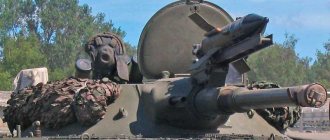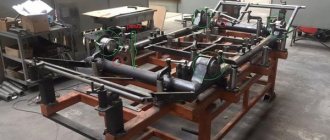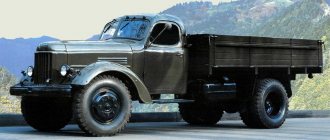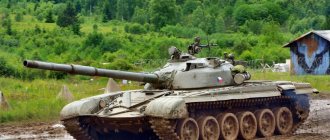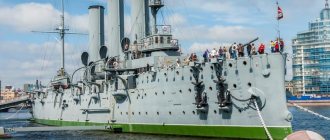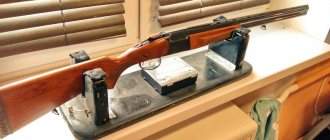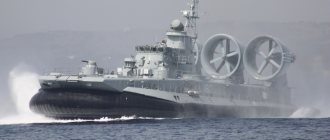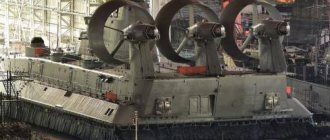The term “weapons of Victory” usually refers to aircraft, tanks, artillery installations, and sometimes small arms that reached Berlin. Less significant developments are mentioned less often, but they also went through the entire war and made their important contribution. For example, the V-2 diesel engine, without which the T-34 tank would not be possible. As is known, the requirements for military and strategic products are more stringent than for “civilian” equipment. Since their actual service life often exceeds thirty years - not only in Russia, but also in the armies of most countries. If we are talking about tank engines, they naturally must be reliable, undemanding in terms of fuel quality, convenient for maintenance and some types of repairs in extreme conditions, and with a service life sufficient by military standards. And at the same time correctly produce basic characteristics. The approach to designing such engines is special. And the result is usually decent. But what happened with the V-2 diesel engine was a phenomenal case.
History of the creation of the B-2
His life began at the Kharkov Locomotive Plant named after. Comintern, whose design department in 1931 received a government order for high-speed diesel for tanks. And it was immediately renamed to the diesel department. The assignment specified a power of 300 hp. at 1600 rpm, despite the fact that typical diesel engines of that time had an operating crankshaft speed of no more than 250 rpm. Since the plant had never done anything like this before, we began development from afar, with a discussion of the design - in-line, V-shaped or star-shaped. We settled on the V12 configuration with water cooling, electric start and Bosch fuel equipment - with a further transition to a completely domestic one, which also had to be created from scratch. First they built a single-cylinder engine, then a two-cylinder section - and it took a long time to fine-tune it, achieving 70 hp. at 1700 rpm and specific gravity 2 kg/hp. A record low specific gravity was also specified in the assignment. In 1933, the efficient, but unfinished V12 underwent bench tests, where it constantly broke down, smoked terribly and vibrated heavily.
The V-2 engine in its original form spent more than 20 years in military service. Some copies are still in use today. Several more found peace in various museums.
The BT-5 test tank, equipped with such an engine, could not reach the test site for a long time. Either the crankcase cracked, or the crankshaft bearings were destroyed, or something else, and to solve many problems it was necessary to create new technologies and new materials - first of all, types of steel and aluminum alloys. And purchase new equipment abroad. Nevertheless, in 1935, tanks with such diesel engines were presented to a government commission, and additional workshops were built at KhPZ for the production of engines - the “diesel department” was transformed into a pilot plant. In the process of fine-tuning the engine, its secondary purpose was taken into account - the possibility of use on airplanes. Already in 1936, the R-5 aircraft with the BD-2A diesel engine (the second high-speed aviation diesel) took off, but this engine was never in demand in aviation - in particular, due to the appearance of more suitable units created by specialized institutes in these same years. In the main tank direction, things progressed slowly and hard. The diesel engine still consumed too much oil and fuel. Some parts regularly broke down, and the too smoky exhaust unmasked the car, which customers didn’t particularly like. The development team was reinforced with military engineers. In 1937, the engine received the name V-2, under which it entered world history. And the team was strengthened once again by leading engineers from the Central Institute of Aviation Motors. Some of the technical problems were entrusted to the Ukrainian Institute of Aircraft Engine Engineering (later it was annexed to the plant), which came to the conclusion that it was necessary to improve the accuracy of manufacturing and processing of parts. The proprietary 12-piston fuel pump also required fine-tuning.
The 580-horsepower V-55V engine was used on T-62 tanks produced from 1961 to 1975. In total, about 20,000 vehicles were produced - the tanks themselves and various equipment created on their basis.
At state tests in 1938, all three second-generation V-2 engines failed. The first one had a jammed piston, the second one had cracked cylinders, and the third one had a cracked crankcase. Based on the test results, almost all technological operations were changed, the fuel and oil pumps were replaced. This was followed by new tests and new changes. All this went in parallel with the identification of “enemies of the people” and the transformation of the department into a huge State Plant No. 75 to produce 10,000 engines per year, for which hundreds of machines were imported and installed. In 1939, the engines finally passed state tests, receiving a “good” rating and approval for mass production. Which was also debugged painfully and for a long time, which was, however, interrupted by the hasty evacuation of the plant to Chelyabinsk - the war began. True, even before that, the V-2 diesel engine had undergone baptism of fire in real military operations, being installed on heavy KV tanks.
Engine prototype
In 1931, the Soviet government set a course for improving military equipment. At the same time, the Kharkov Locomotive Plant named after. The Comintern received the task of developing a new diesel engine for tanks and aircraft.
The novelty of the development had to lie in fundamentally new characteristics of the motor. The nominal crankshaft speed of diesel engines of that time was 260 rpm. Then, as in the task, it was stipulated that the new engine should produce 300 hp at a rotation speed of 1600 rpm. And this already imposed completely different requirements on the methods of developing components and assemblies. Technologies that would make it possible to create such an engine in the Soviet Union did not exist.
The design bureau was renamed Diesel, and work began. After discussing possible design options, we settled on a V-shaped 12-cylinder engine, 6 cylinders in each row. It was supposed to be started by an electric starter. At that time there was no fuel equipment that could provide fuel for such an engine. Therefore, it was decided to install a Bosch injection pump as a high-pressure fuel pump, which was subsequently planned to be replaced with a pump of our own production.
Two years passed before the creation of the first test sample. Since the engine was planned to be used not only in Soviet tank construction, but also in aircraft construction on heavy bombers, the low weight of the engine was specially stipulated.
B-2 in the final version
The result was a motor about which they would later write that, from a design point of view, it was far ahead of its time. And in a number of characteristics, for another thirty years it was superior to analogues of real and potential opponents. Although it was far from perfect and had many areas for modernization and improvement. Some army technology experts believe that the fundamentally new Soviet military diesel engines, created in the 1960–1970s, were inferior to the V-2 family of diesel engines and were adopted for service only for the reason that it was becoming indecent not to replace the “obsolete” with something modern. The cylinder block and crankcase are made of an aluminum-silicon alloy, the pistons are made of duralumin. Four valves per cylinder, overhead camshafts, direct fuel injection. Duplicate starting system - electric starter or compressed air from cylinders. Almost the entire technical description is a list of advanced and innovative solutions of that time.
The V-46 engine is used on the T-72 medium tanks, which have been put into service since 1973. Thanks to the supercharging system, 780 hp were produced. Frankly speaking, there are few fundamental differences from the B-2.
It turned out to be ultra-light, with an outstanding specific gravity, economical and powerful, and the power was easily varied by local changes in the operating speed of the crankshaft and the compression ratio. Even before the start of the war, there were three versions in constant production - 375-, 500- and 600-horsepower, for equipment of different weight categories. Having fitted the V-2 with a supercharging system from the AM-38 aircraft engine, we got 850 hp. and was immediately tested on the experimental KV-3 heavy tank. As they say, any more or less suitable mixture of hydrocarbons, starting from household kerosene, could be poured into the tank of a car with a V-2 family engine. This was a strong argument in the conditions of a difficult, protracted war - dilapidated communications and difficulty in providing everyone with everything they needed.
For the development of the V-2 engine T.P. Chupakhin was awarded the Stalin Prize, and in the fall of 1941, Plant No. 75 was awarded the Order of Lenin. At that time, this plant was evacuated to Chelyabinsk and merged with the Chelyabinsk Kirov Plant (ChKZ). I.Ya. was appointed chief designer of ChKZ for diesel engines. Trashutina.
However, the engine never became reliable, despite the requirements of the People's Commissar of Tank Industry V.A. Malysheva. It often broke down - both at the front and during various tests during the war, although from the beginning of 1941 engines of the “fourth series” were already produced. Both design miscalculations and manufacturing technology violations were let down - largely forced, since there were not enough necessary materials, there was no time to renew worn-out equipment, and production was adjusted in a wild rush. It was noted, in particular, that dirt “from the street” gets into the combustion chambers through various filters and the warranty period of 150 hours is not met in most cases. While the required diesel resource for the T-34 tank was 350 hours. In the fall of 1942, T-34 and KB-1 tanks were sent to the United States for study. Their tests overseas began on November 29 and lasted exactly a year. As a result, the T-34’s engine failed after 72.5 hours, and the KB-1’s after 66.4 hours. The T-34 traveled only 665 km. The engine worked under load for 58.45 hours, without load - 14.05 hours. In total there were 14 breakdowns. In conclusion, based on the test results, it was noted that the air cleaner is completely unsuitable for this engine, practically does not retain dust, and, on the contrary, accelerates wear and reduces reliability.
The T-34 is considered the world's first tank designed for a diesel engine. Its success was predetermined, as they say, by the use of the latest highly economical diesel engine of the B-2 aviation type. Therefore, modernization and “tightening the screws” went on continuously. And if in 1943 the usual service life of the engine was 300–400 km, then by the end of the war it exceeded 1200 km. And the total number of breakdowns was reduced from 26 to 9 per 1000 km.
Plant No. 75 could not cope with the needs of the front, and factories No. 76 were built in Sverdlovsk and No. 77 in Barnaul, which produced the same B-2 and its various versions. The vast majority of tanks and some self-propelled guns that participated in the Great Patriotic War were equipped with products from these three factories. The Chelyabinsk Tractor Plant produced diesel engines in versions for the T-34 medium tank, heavy KV series tanks, T-50 and BT-7M light tanks, and the Voroshilovets artillery tractor. Based on the V-2, the V-12 was developed, later used in the IS-4 tanks (it managed to fight for about a month) and T-10.
Engine modification
They tried to create the engine from materials that had not previously been used to build diesel engines. For example, the cylinder block was made of aluminum, and it, unable to withstand tests on the bench, constantly cracked. High power caused the light, unbalanced motor to vibrate violently.
The BT-5 tank, on which the diesel engine was tested, never reached the test site under its own power. Troubleshooting of the engine showed that the crankcase block and crankshaft bearings were destroyed. In order for the design embodied in paper to migrate to life, new materials were needed. The equipment used to make the parts was also unsuitable. There was not enough manufacturing precision class.
In 1935, the Kharkov Locomotive Plant was replenished with experimental workshops for the production of diesel engines. Having eliminated a number of shortcomings, the BD-2A engine was installed on the R-5 aircraft. The bomber took off, but the low reliability of the engine did not allow it to be used for its intended purpose. Moreover, by that time more acceptable options for aircraft engines had arrived.
Preparing the diesel engine for installation on the tank was difficult. The selection committee was not satisfied with the high smoke, which was a strong unmasking factor. In addition, the high fuel and oil consumption was unacceptable for military equipment, which must have a large range without refueling.
Use of the V-2 engine in civilian life
The full potential of the B-2 design could not be revealed either before or during the war - there was no time to unlock the potential. But a set of various small imperfections turned out to be an excellent basis for development, and the concept itself was optimal. After the war, the family was gradually replenished with tank engines V-45, V-46, V-54, V-55, V-58, V-59, V-84, V-85, V-88, V-90, V-92 , B-93 and so on. Moreover, the development has not yet been completed, and individual engines of the family are still being mass-produced.
The modern T-90 tank today is equipped with the V-84MS engine (840 hp) or its modernized version V-92S2 (1000 hp). Both of them are direct descendants and further development of the V-2 concept.
The T-72 tank, the main battle tank of the USSR, produced in a circulation of about 30 thousand copies, received a 780-horsepower V-46 engine. Russia's modern main battle tank, the T-90, was originally equipped with a 1,000-horsepower supercharged V-92 engine. Many of the points in the descriptions of the V-2 and V-92 completely coincide: four-stroke, V-shaped, 12-cylinder, multi-fuel, liquid cooling, direct fuel injection, aluminum alloys in the cylinder block, crankcase, pistons. For infantry fighting vehicles and other less heavy equipment, they created an in-line engine half from the B-2, and the first developments of such a design were carried out and tested in 1939. Also among the direct descendants of the V-2 is a new generation of X-shaped tank diesel engines produced by ChTZ (used on the BMD-3, BTR-90), which use halves in another dimension - V6. He was also useful in the civil service. In the Barnaultransmash association (formerly plant No. 77), the in-line D6 was created from the V-2, and later the full-size D12. They were installed on many river boats and tugs, on motor ships of the Moskva and Moskvich series.
The TGK2 shunting diesel locomotive, produced with a total circulation of ten thousand copies, received the 1D6 modification, and the 1D12 was installed on MAZ mining dump trucks. Heavy tractors, locomotives, tractors, various special machines - wherever a powerful, reliable diesel engine was required, you will find the closest relatives of the great B-2 engine.
And the “144th Armored Repair Plant,” which served as part of the 3rd Ukrainian Front from Stalingrad to Vienna, still offers services for the repair and restoration of B-2 diesel engines. Although it has long since become a joint-stock company and settled in Sverdlovsk-19. And frankly, I can’t believe that the high overall power, trouble-free and reliable operation, good maintainability, convenience and ease of maintenance of modern engines of this family are just advertising hype. Most likely, this is actually the case. For that, thanks to everyone who created and improved this long-lived motor.
Characteristics and design of the T-34 tank engine
The high-speed, compressorless diesel B-2 was water-cooled. The cylinder blocks were located at an angle of 60 degrees relative to each other.
The motor operation was carried out as follows:
- During the intake stroke, atmospheric air is supplied through the open intake valves.
- The valves close and the compression stroke occurs. The air pressure increases to 35 atm, and the temperature rises to 600 °C.
- At the end of the compression stroke, the fuel pump supplies fuel under a pressure of 200 atm through the injector, which ignites at high temperature.
- The gases begin to expand sharply, increasing the pressure to 90 atm. The engine's power stroke occurs.
- The exhaust valves open and exhaust gases are released into the exhaust system. The pressure inside the combustion chamber drops to 3-4 atm.
Then the cycle repeats.
